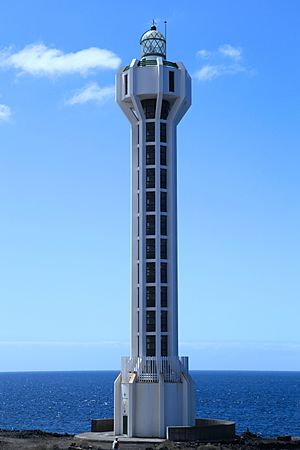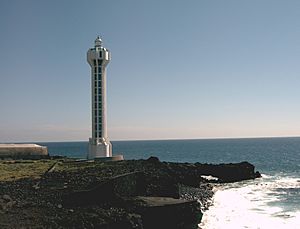Punta Lava Lighthouse facts for kids
 |
|
| Location | Tazacorte, La Palma |
|---|---|
| Coordinates | 28°35′48″N 17°55′32″W / 28.59667°N 17.92568°W |
| Year first constructed | 1993 |
| Height | 48 metres (157 ft) |
| Focal height | 51 metres (167 ft) |
| Range | 20 nautical miles (37 km; 23 mi) |
| Characteristic | Fl(1+2) W 20s |
The Punta Lava Lighthouse (which means Faro de Punta Lava in Spanish) is an active lighthouse built in the 1990s. It stands on the beautiful Canary island of La Palma, which is part of Spain.
You can find this lighthouse in the area of Tazacorte. It is close to a small village called La Bombilla, on the western side of the island. Another larger town, Puerto Naos, is about 2 kilometers to the southwest.
This lighthouse is one of four main lighthouses on La Palma. Each one helps guide ships around a different side of the island. Punta Lava and Arenas Blancas are modern lighthouses on the west and east coasts. The older lighthouses, Punta Cumplida and Fuencaliente, are at the northern and southern tips.
What is Punta Lava?
The land where the lighthouse stands is called Punta Lava, or "Lava Point." This area was created by a volcanic eruption in 1949. During that year, hot lava flowed from the Cumbre Vieja volcano. It traveled all the way down to the Atlantic Ocean.
The lava formed a large, flat area of new land in the sea. This new land is about six kilometers long and three and a half kilometers wide. Besides the lighthouse, Punta Lava is home to the village of La Bombilla. You can also find many banana farms and a beach called Playa Charcon there.
Experts decided a lighthouse was needed on the west coast in the 1980s. This was part of a plan to improve lights for ships around the Canary Islands. At first, they thought about putting the light further north, near Los Llanos de Aridane.
Lighthouse Design and Light
The Punta Lava Lighthouse has a unique and modern design. It is a white tower made of concrete and has eight sides. The tower is 48 meters (about 157 feet) tall. It was finished in 1993 and started working in 1996.
The lighthouse stands on a cliff right next to the ocean. The light itself is about three meters above sea level. This means the light shines from a height of 51 meters (about 167 feet) above the water. Its light can be seen up to 20 nautical miles away.
The light flashes in a special pattern. It sends out three white flashes every twenty seconds. In 1998, the lighthouse got a new lens system. Later, its lamps were updated with modern sealed beam units.
The lighthouse is managed by the port authority in province of Santa Cruz de Tenerife. It has special international numbers to identify it: D2851 and 113-23801.
Map
See also
 In Spanish: Faro de Punta Lava para niños
In Spanish: Faro de Punta Lava para niños
- List of lighthouses in the Canary Islands
- List of lighthouses in Spain


